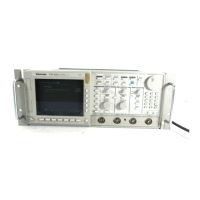Appendix B: Algorithms
B–8
TDS 500D, TDS 600B, & TDS 700D User Manual
Timing measurement. The amount of time between the and
crossings of two different traces, or two different places on the same trace.
Delay measurements are actually a group of measurements. To get a specific
delay measurement, you must specify the target and reference crossing polarities
and the reference search direction.
= the time from one crossing on the source waveform to the
crossing on the second waveform.
Delay is not available in the Snapshot display.
Optical measurement between 1 and 100. In real circuits, the extinction ratio is
typically 8 to 30. Values v 1 or w 100 generate errors. An Extinction Ratio of 1
or 100 means a problem exists. The optical probe and the oscilloscope must be
calibrated. All inputs are micro watts and are not negative. Extinction ratio is
dimensionless.
Extinction Ratio = (High/Low)
Low ≥ 1 mW
Optical measurement.
Extinction % = 100.0 / Extinction Ratio
Optical measurement. Extinction dB is typically 8 to 12 db. To exceed this range
the input may be from nonoptical probes or noncommunication lasers.
Extinction dB =
Timing measurement. The time taken for the falling edge of a pulse to drop from
a value (default = 90%) to a value (default = 10%).
Figure B–2 shows a falling edge with the two crossings necessary to calculate a
Fall measurement.
1. Searching from to , find the first sample in the measurement zone
greater than .
2. From this sample, continue the search to find the first (negative) crossing of
. The time of this crossing is . (Use linear interpolation if
necessary.)
Delay
Extinction Ratio
Extinction %
Extinction dB
Fall Time

